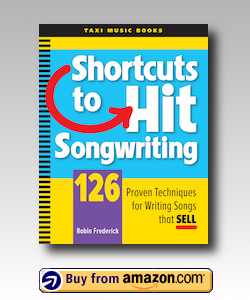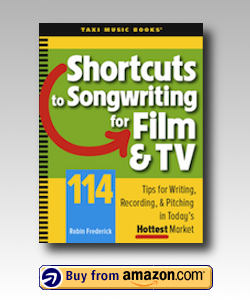‣ 5 Magic Song Tips
These five simple song craft techniques will give your songs emotional impact and make listeners want to hear them again and again. For a step-by-step, "how-to" guide to writing a song, read my article Notes On Songwriting.
TIP #1: Begin With a Blockbuster Themeby Robin FrederickBased on "Shortcuts to Hit Songwriting." Available at Amazon.com. Some songwriters spend a lot of time waiting. Waiting for inspiration. Waiting for an idea. Waiting. I don't want you to wait. I want you to start doing, writing, creating. Now. One of the things songwriters most often seem to wait for is an idea that will launch them into the deep emotional waters of a song. Not only is it unnecessary to hang around hoping an idea will magically appear, it can lead to repetition and stagnation of your creative muscles. It's funny how, once an idea has worked, it tends to reappear over and over again. So, here's an idea... You might have noticed that songs use many of the same themes that drive other types of dramatic entertainment. Just check out the list of top ten romantic films of all time or today's favorite contemporary TV dramas. While hit songs tend to focus on relationships and emotions rather than car chases and shoot-outs, they share many of the same dramatic elements: Who is involved? What will happen next? How does the main character feel about it? You can use popular movies and TV shows to lead you to themes that pack a big emotional punch both for you and your listeners. So, yes, I'm telling you to watch TV and go to the movies. Remember, it's important for you to be present emotionally in your song so start by looking for a scene that draws your emotional attention. When did you find yourself getting involved with a character? When did you identify with the character? What was the peak emotional moment for you in this character's story? Any of these points in a storyline can provide a theme for a song. GO AHEAD & DO IT! Watch a TV drama and try to sum up the main idea behind the story in a single sentence. How are the characters expressing that idea? What are they feeling at the beginning of the story? How did that change by the end? Try writing a song that communicates a similar idea or emotional message. |
TIP #2: Put a Family of Images to Work for Youby Robin FrederickBased on "Shortcuts to Hit Songwriting." Available at Amazon.com. Using an image is like opening a door into your listener's head. It's impossible not to see a mental picture when we hear an image-word. If I say 'rain', you picture rain. But that's not all that happens; along with that picture of rain, come all the associations you have with it: a grey sky, the physical sensation of humidity, cozy indoors, cold and wet outdoors. Images don't arrive alone. They are always accompanied by a gaggle of related images, ideas, sensations, and experiences. Think of it as a family that stays together. As a songwriter, you can use this family to your advantage. While you can't control all of the responses to an image your listener will have, there are plenty of shared associations you can count on. Associations like these add depth and richness to your lyric with no extra effort on your part. Play with them, use them to underscore your theme, you can get a lot of bang for your buck with an image that's got a big family. Be alert to images with associations that conflict with your theme or with each other. These can create a distraction that drags your song down. If the singer is driving "a flashy pink Cadillac" with its suggestion of ego and impulsiveness, it will be difficult for us to believe he's also "the salt of the earth" and "dependable as the rising sun." Your listeners will end up spending a lot of time trying to reconcile these two sets of images instead of listening to your song. This is an extreme example; look for more subtle occurrences where one image is undermining another. Of course, it's fine to have contrasting images if you want to demonstrate the difference between two people or things. A phrase like "I'm a prisoner of your love," can work for and against you. The image of a 'prisoner' has a lot of associations with it that might add depth to your theme but it's been so overused that listeners don't 'see' it anymore. To make an image like this work for you, freshen it up by varying the image itself: "Your love is holding me hostage." Or, give us a new insight or twist on the image in the surrounding lines: "I'd give up my freedom to become / a prisoner of your love." GO AHEAD & DO IT! Go through some of your own song lyrics and see if you can put image families to work for you! |
TIP #3: Write a memorable melody!by Robin FrederickBased on "Shortcuts to Hit Songwriting." Available at Amazon.com. It has been said many times that no one can teach you how to write a great melody. This may be true but there are a few tricks that will help you write a memorable one. Memorable, emotionally powerful melodies use repetition and variation. A melody with no repetition sounds unfocused and weak, as if it's wandering around with nowhere to go. Listeners quickly lose interest and tune out. A melody with too much repetition is boring. Good melodies walk the line in between - mixing repeated phrases with variation. As you listen to a song, you can usually feel where melodic phrases begin and end; there is a natural break there. Melodic phrases can be short (one bar) or long (four bars or more). Varying the length of your melodic phrases is a good way to keep your melody interesting. For example: try starting a verse with two short phrases followed by a long phrase. You can hear this in a song like "Breakaway," a big hit for Kelly Clarkson. Melody also makes use of pace and rhythm; notes are long or short, creating a pattern that can be repeated or varied. Just think of the nursery rhyme "Twinkle, Twinkle, Little Star." It's a series of two-note phrases (Twink-le / twink-le / lit-tle), followed by a held-out note (star). Then the whole line is repeated. Each two-note phrase is on a different pitch. This is a great way to write a melody that's easy to remember: the rhythm pattern stays the same while the note pitches change. You can hear a MUCH more sophisticated example in Paul McCartney's classic Pop song "Yesterday." GO AHEAD & DO IT! - Choose a hit song you like. Identify the melodic phrases. Identify the mix of long and short phrases. Notice which ones, if any, are repeated exactly - rhythm and note pitches. Notice which ones have the same rhythm pattern but use different note pitches. These phrasing concepts may be new ideas for you and it may take some practice to begin to recognize phrasing patterns. For more information, read my book "Shortcuts to Hit Songwriting" available at Amazon.com. |
TIP #4: Use Contrast to Get Attentionby Robin FrederickBased on "Shortcuts to Hit Songwriting." Available at Amazon.com. Imagine you and I are standing in a room full of people. If I suddenly start yelling, I will get everyone's attention. But if I keep on yelling at the same level for awhile, what happens? Pretty soon they all get bored and stop listening (and probably leave). It's natural to think that being loud, is an attention-getter but if loudness becomes the norm then it ceases to be something we are interested in. We are 'hardwired' to notice change. When something changes, we check it out. What's happening? What's different? It's a survival mechanism, like the 'fight or flight' response. Once we are satisfied that everything is safe, we no longer need to devote energy to it and we disengage our attention. When I started yelling, everyone noticed the change; when they determined there was no threat, they disengaged their attention.
So, let's try this. What happens if I yell for 30 seconds, then speak softly for 30 seconds, then yell again? Each of those changes in volume level will attract attention. It's the change -- the AMOUNT of change, which we call CONTRAST -- that gets attention. Contrast says: "Hey, notice THIS! It's different." The more contrast, the more difference, the more it captures attention. |
TIP #5: Write in a Genreby Robin Frederick.Based on "Shortcuts to Hit Songwriting." Available at Amazon.com. Like ice cream, songs come in different flavors: strawberry, chocolate, peach, and rocky road. And, like ice cream flavors, there are very real differences between the four mainstream music genres-Country, Pop, Rock, and R&B/Soul-and each one appeals to a different audience. CHOOSE A GENRE AND GET FAMILIAR WITH IT Spend some time listening to current hits in the genre you want to write in. If you like Country music, listen to the top 20 current Country hits and study the chords, melodies, and lyrics to see what they have in common. What is it that Country audiences are excited about right now? If you're interested in Rock, Pop, R&B/Soul or Hip-Hop, check out the current radio airplay charts to see which songs are getting the most play. These are the ones that listeners are eating up! You can find up-to-date Radio Airplay Charts at http://www.bdsradio.com. Click on "Select a Format" and check out the ones you're interested in. (If you don't know which charts you're interested in, check out a few. This is essential research for songwriters!) Once you've found a genre you like and a couple of songs, listen to them carefully and study your genre. Look for the general, broad characteristics of your genre by asking the following questions as you listen. LYRICS: What themes are featured? What kind of language is used? What sorts of characters turn up in these songs? MELODY: How much contrast is being used between sections? Are the melodies complicated or simple? How much repetition is used, how much variation in the melody line? CHORDS: Do you hear basic three-note chords primarily? What other kinds of chords are being played? How frequently are the chords changing? These are just a few of the questions that will help you study your genre. No one wants to sound exactly like everyone else but you do want your song to incorporate enough of a genre's characteristic sound so that it will fit into a radio format. Blend it with your own style to make sure YOU still sound like YOU but give it an extra push toward radio. GO AHEAD & DO IT! Go to wwwBDSradio.com and look at some of the radio airplay charts. Pick one or two songs that sound interesting and listen to them on Spotify, Rdio, or buy them on iTunes. While you listen, go through the above list of questions and see how many you can answer. Try listening to songs in a range of genres and compare them to hear the differences. |
Want even more? Click here for three hot songwriting tips!
Robin Frederick has written more than 500 songs for television, records, theater, and audio products. She is a former Director of A&R for Rhino Records , Executive Producer of 60 albums, and the author of "Shortcuts to Hit Songwriting." Robin currently oversees the A&R Team for TAXI, the world's leading independent A&R company.
Robin's books are used to teach songwriting at top universities and schools in the U.S. They're fun to read and filled with practical, real world information. Buy them at Amazon.com...
Shortcuts to Hit Songwriting
Shortcuts to Songwriting for Film & TV






